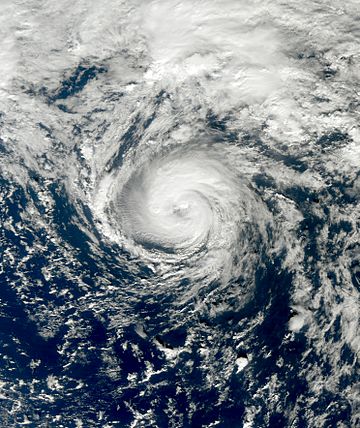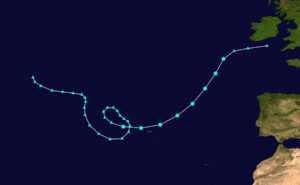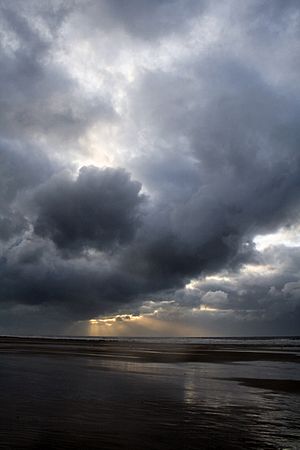Tropical Storm Grace (2009) facts for kids
| Tropical storm (SSHWS/NWS) | |

Tropical Storm Grace at peak intensity
|
|
| Formed | October 4, 2009 |
|---|---|
| Dissipated | October 6, 2009 |
| Highest winds | 1-minute sustained: 65 mph (100 km/h) |
| Lowest pressure | 986 mbar (hPa); 29.12 inHg |
| Fatalities | None reported |
| Damage | Minimal |
| Areas affected | Azores, Portugal, and the British Isles |
| Part of the 2009 Atlantic hurricane season | |
Tropical Storm Grace was a very unusual storm that formed in the Atlantic Ocean. It was the seventh named storm of the 2009 Atlantic hurricane season. Grace started near the Azores islands on October 4, 2009. Its winds reached about 65 mph (105 km/h). But it didn't last long. Cold ocean water made it weaker, and it faded away over England by October 6. Grace was special because it formed much farther north and east in the Atlantic than most tropical storms.
Grace didn't cause much damage on land. When it passed the Azores, people felt strong winds and some rain. In Portugal, the storm helped cause heavy rain and flooding. What was left of Tropical Storm Grace then moved over parts of Ireland and the United Kingdom. In these areas, about 2 in (51 mm) of rain fell, and winds became strong. Luckily, there was no serious damage.
How Tropical Storm Grace Formed
Tropical Storm Grace began from a large extratropical cyclone. This is a type of storm that forms outside of tropical areas. It started on September 27, 2009, east of Newfoundland. Over time, it began to look more like a tropical storm.
By October 1, clouds and thunderstorms, called convection, started to gather near the storm's center. The National Hurricane Center (NHC) stopped watching it for a short time. But the storm kept moving in a loop near the Azores. On October 4, more convection formed. It officially became a tropical storm near São Miguel Island.
The NHC named the storm "Grace" on October 4. It was the seventh named storm of the 2009 Atlantic hurricane season. Grace had strong thunderstorms and even a clear spot in the middle, like an eye. It was over waters that are usually too cold for tropical storms. But because there wasn't much wind shear (winds blowing in different directions), it stayed together. Grace moved northeast and even got a little stronger over the colder waters.
A larger storm near Grace caused it to weaken. By this time, Grace was over water that was only about 18 °C (64 °F). This stopped it from getting stronger. On October 6, Grace joined with a weather front over the northeastern Atlantic Ocean. What was left of Grace continued for about 18 hours. It finally disappeared in the Celtic Sea on October 7.
Grace's Impact and Special Records
When Grace was near the Azores, some islands had light rain and strong winds. Wind gusts reached 44 mph (71 km/h) in Ponta Delgada. On October 6, the storm's rainbands caused heavy rain and strong winds in parts of Portugal. This led to some streets getting flooded. In the mountains, wind gusts might have been stronger than 80 km/h (50 mph).
Because the storm was moving very fast when it reached the United Kingdom, the rain wasn't extremely heavy. In Ireland, 1.18 in (30 mm) of rain fell in the city of Cork. Winds in the city were about 23 mph (37 km/h). The most rain in Ireland was 48 mm (1.9 in) in Wexford. The strongest winds were like a gale, which is a Force 8 on the Beaufort scale. Near the coast of Wales, a special buoy recorded winds of 41 mph (66 km/h). This is as strong as a small tropical storm. Later on October 6, Grace moved over Wales, bringing more rain and strong winds.
Grace was special because of where it formed. At first, experts thought it became a tropical storm very far north. This would have made it the second farthest-north tropical storm to form in the Atlantic. Only Tropical Storm Alberto in 1988 had formed farther north. However, after the hurricane season, they found that Grace actually became a tropical storm 12 hours earlier than first thought. This meant it formed a bit farther south. Still, its location was very unusual for a tropical storm.
The NHC also said that they didn't expect Grace to form. For three days, it wasn't even mentioned in their weather forecasts. This was because of the storm's unusual location.
Related pages



